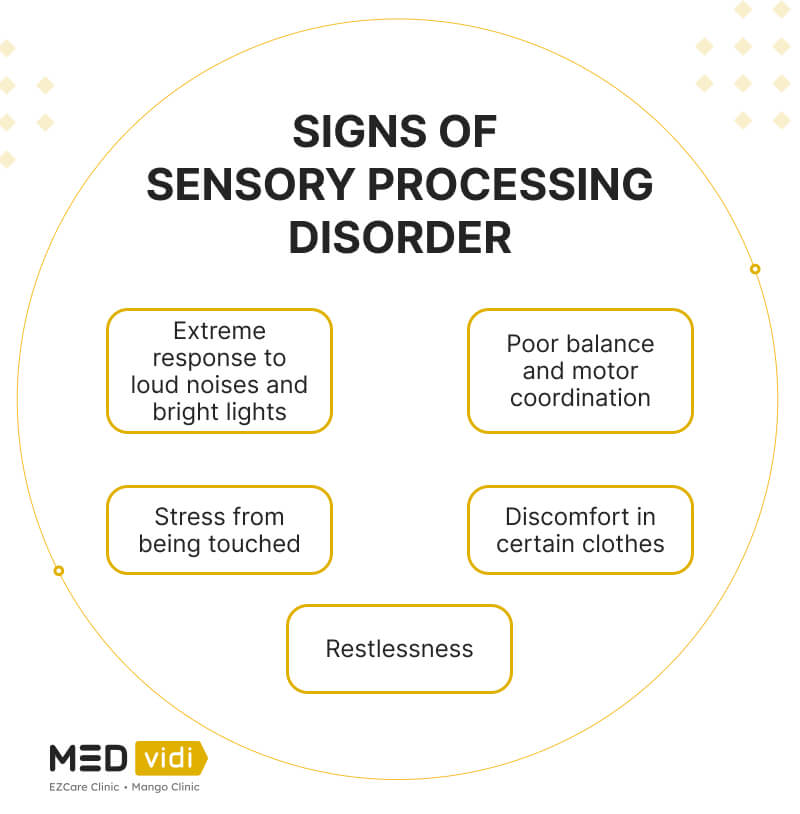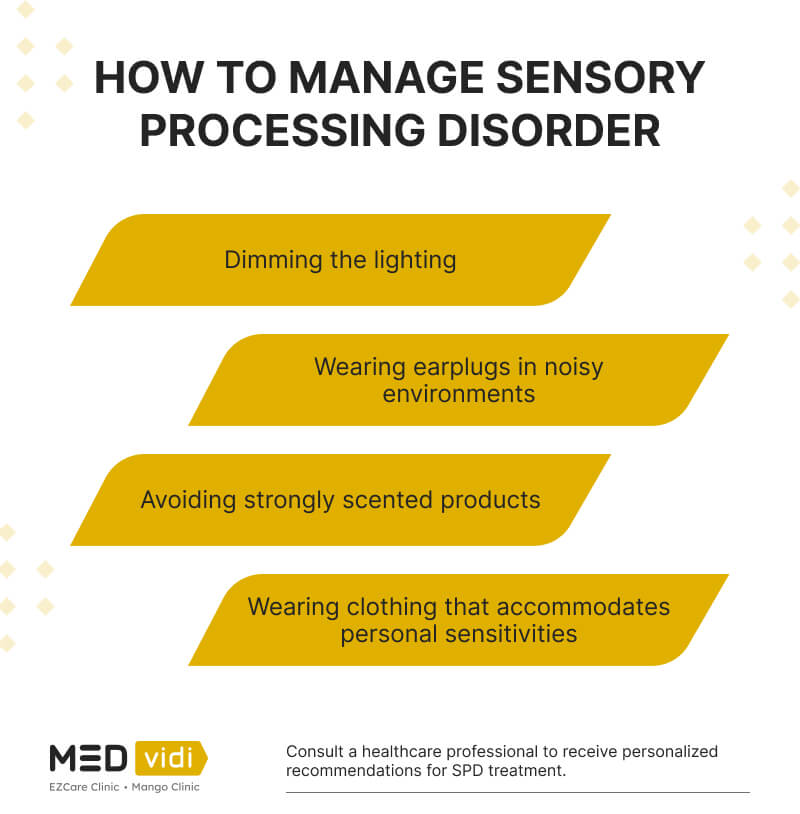Highlights
- Sensory processing disorder (SPD) is a neurological condition where the brain struggles to process sensory input properly, which can lead to sensory overload.
- SPD frequently coexists with attention deficit hyperactivity disorder, anxiety disorders, autism spectrum disorder, and others.
- SPD is not officially recognized in the DSM-5, making diagnosis complex. However, it is possible to get personalized recommendations from a healthcare provider experienced in treating SPD.
- While there is no standardized treatment, occupational therapy, sensory integration, lifestyle changes, and mindfulness techniques can help individuals manage sensory processing disorder.
Have you ever been in a crowded room, in a hall with fluorescent humming lights, or crossed someone wearing a strong scent — and felt so strongly bothered that it overwhelmed you? This is similar to what people with
Sensory processing disorder is a psychological condition wherein the brain does not perceive sensory information properly. The symptoms usually present in children, but if left untreated, the symptoms can persist into adulthood. Read on to learn the details of diagnosis and treatment of SPD.
Get personalized care

Sensory Issues in Adults Explained
Sensory overload in adults occurs when any of the senses — taste, sight, smell, hearing, or touch — have too much information to process. This overwhelms the brain and may lead to a fight, flight, or freeze response.
In normal circumstances, the brain processes everything that is brought to its attention via the senses. However, some people may be hypersensitive to particular sounds, sights, or textures. They may also feel overwhelmed in crowded events, heavy traffic, when exposed to strong smells, and even feeling deep emotions.
What Is Sensory Processing Disorder (SPD)?
SPD is a neurologic disorder in which the brain fails to correctly receive, process, and appropriately respond to sensory input. This can affect any of the five major senses, as well as proprioception (self-awareness about your physical position and movement), and vestibular sense (or balance).
Three main common patterns of SPD are the following:
- Sensory discrimination disorder: This involves difficulty identifying and discriminating between different types of sensory stimuli (sounds, smells, tastes, etc.).
- Sensory modulation disorder: This involves difficulties with sensory processing and behavioral expressions. Subjects with this pattern may be hypersensitive (over-responsive) or hyposensitive (under-responsive).
- Sensory-based motor disorder: This involves difficulties processing and interpreting sensory info, which in turn, causes problems with movement, coordination, and posture. A wide range of activities can be affected, like writing, tying shoelaces, or utensil use.
What Does SPD in Adulthood Feel Like?
Since
Generally, the way that SPD manifests includes the following:
- Motor Functioning: A person becomes clumsy while doing complicated motor activities such as driving or operating machinery.
- Auditory Functioning: Routine and/or loud sounds disturb adults with SPD more than others. Everyday sounds may also cause stress.
- Visual Sensitivity: Seeing bright lights or quick movements may be difficult for them. They get tired or have trouble concentrating in crowded places.
- Vestibular Functioning: Taking a walk on uneven surfaces and moving in elevators, automobiles, or amusement park rides can be difficult for individuals with SPD.
- Tactile Functioning: Certain styles of clothing, lights, unwanted touches, or standing in crowded settings make life harder for people with SPD.

General Sensory Processing Disorder Symptoms in Adults
Sensory processing disorder may present in different ways, sometimes interfering with daily functioning and overall well-being. Some common symptoms include:
- Sensory Over-Responsiveness (Hypersensitivity): A person feels over-reactive to stimuli; they are sensitive to bright lights, loud sounds, strong smells, or harsh textures, but it may also happen in a mild environment. These sensitivities might reach an overwhelming or even painful degree.
- Sensory Under-Responsiveness (Hyposensitivity): A person has insufficient awareness of their sensory intake, which leads to difficulties in responding and timely reacting to the stimuli. Often, they require stronger sensations, such as louder music or spicier food, or more vigorous physical activities to meet their needs. This may also contribute to decreased sensitivity to pain, temperature, or even physical touch, raising risk of injury or unawareness of physical needs.
- Motor Coordination Difficulties: One may find it difficult to coordinate fine and gross movements, often tending to be more ‘clumsy’, constantly tripping over their own feet. They may also have difficulties with hand-eye coordination, such as writing, typing, or working with tools.
- Emotional Dysregulation: Sensory overload can cause irritation, frustration, depression, and anxiety, affecting the emotional state. These problems can lead to mood swings or emotional overreaction and instability.
- Social Interaction Challenges: A person with sensory processing disorder may find social interactions tough because sensory challenges may interfere with communication, attention, and comfort in social situations. Background noise, crowded spaces, or unpredictable environments can cause the inability to engage fully in conversation, and one may be perceived as being distracted or withdrawn.
The SPD Diagnostic Criteria
Even though some medical organizations accept SPD, the American Psychiatric Association does not include it in the DSM-5 (Diagnostic and Statistical Manual of Mental Disorders). This makes diagnosing sensory processing disorder in adults not as straightforward. Practitioners can rely on childhood background and behaviors such as eye movements, reaction to stimuli, and balance (vestibular function), as well as questionnaires focused on evaluating prenatal, birth, and developmental stages. This helps rule out other neurological disorders, such as autism spectrum disorder (ASD), ADHD, and anxiety disorders.

Common Causes of Sensory Processing Disorder in Adults
Some possible
- Birth complications and problems during the prenatal stage
- Low birth weight of under 2.2 kg
- Those whose birth occurred after less than 32 weeks have an incidence of 46% for SPD
- Experiences of parental stress
- Alcohol and drug abuse during pregnancy
- Genetic factors
- Heavy exposure to chemical substances within the childhood stage
- Weak sensory stimulation
While these factors are widely recognized, researchers are also investigating the connection between
Sensory Processing Disorder and ADHD
SPD can often be
Impulsiveness, hyperactivity, avoidance, and maladaptive emotion regulation associated with ADHD may play a role in the hypersensitivity to sensory inputs. This can impair the effectiveness of the attempts to regulate sensory stimuli, very similar to what is seen in SPD.
How ADHD and SPD Differ
ADHD is a neurodevelopmental disorder primarily characterized by inattention, impulsivity, and hyperactivity. On the other hand, SPD is a sensory integration disorder associated with the inability to adequately process and respond to sensory information from the environment.
While ADHD involves difficulties with executive functioning such as planning, organization, and time management, the focus of SPD is on sensory processing difficulties, like higher or lower sensitivity and issues with coordination.
If you’re unsure whether your symptoms align more with ADHD or SPD, a medical professional can assess your condition and guide you toward the right treatment options during an online ADHD consultation. To gain initial insights before your appointment, you can also take our free ADHD test.
Sensory Processing Disorder & Other Co-Occurring Conditions
SPD can coexist with other conditions, for example,
How to Treat Sensory Processing Disorder in Adults
Currently, there isn’t a widely acknowledged treatment for SPD in adults. Healthcare providers seldom prescribe medication for SPD; instead, they might recommend therapies and lifestyle changes individualized to a patient’s unique sensory difficulties and needs. It is necessary to determine how each patient reacts to stimuli and sensory input before devising a treatment plan. Potential treatment options include:
- Sensory Integration Therapy: A therapist introduces structured and controlled sensory experiences that challenge the patient but do not overwhelm them. This, in turn, helps in improving sensory modulation, integration, and adaptive behaviors, thus enhancing one’s ability to perform effectively in everyday activities.
- Occupational Therapy: It is highly desirable for SPD patients to improve their concentration through prioritization of their abilities. It enables the patients to improve coordination and strength, which assists them in managing themselves in both social and occupational areas.
- Sensory Diet: This approach involves creating a tailored sensory activity plan that will provide the right volume and intensity of input that a person needs to regulate their processing. With opportunities to engage in sensory activities during the day, these individuals take better control over their sensitivities, resulting in increased attention and improved integration.
- Therapeutic Listening: This involves
auditory programs[8] in an effort to activate the auditory system using sensory processing and self-regulation. The treatment goal is to enhance auditory processing. Accurate sound frequency transmission to direct the sound waves can facilitate learning and management of feelings/emotions in patients with sensory issues. - Speech Improvement: This is directed at improving the speech of SPD patients involving oral-motor control, articulation, and quality voice by specific exercises and interventions.
- Vision Therapy: This program is aimed at improving eye-motor abilities thus improving writing, reading, or navigating their way in traffic.
Generally, the aims of the above therapies involve improving the daily living skills and quality of life of the patient. Therapists work on motor skills, bilateral coordination, and reaction to stimuli.
Lifestyle Tips for People With SPD
Properly chosen lifestyle changes can be a great help for people with sensory processing disorder, for example:
- Keep routine physical activities. Activity can be something as simple as a stroll around the block each day.
- Wear compression garments to control tactile oversensitivity.
- Have sensory-friendly environments at home and at work to avoid overstimulation to achieve a soothing sensory experience that suits your unique needs.
- Develop a daily routine so that there is predictability as to what happens next.
- Engage in creative activities, such as painting, music, or other hobbies that stimulate the senses gently.
- Routine meditation can help the mind focus on specific sensations to achieve much better control over responses.
- Slow, rhythmic pressure movements during massage also help regulate heart and breathing rates to the advantage of a person with SPD.

Living With Sensory Processing Disorder
SPD in adult life comes with a mix of challenges but also brings opportunities for self-discovery. While it can influence some aspects of work or relationships, it is possible to minimize the effects through specific strategies for creating supportive settings and habits:
- One of the first steps in taking control of SPD is knowing your triggers i.e. sounds, lights, textures, or movements. Keeping a diary or log of daily sensory responses helps predict when or in which situations you might become overwhelmed or underwhelmed.
- Flexibility is important when trying to manage SPD. It is also important to acknowledge small achievements. It’s about winning small battles each day to enhance the quality of daily living.
- Creating sensory-friendly environments through low lighting, minimal clutter, and soothing fragrances in the home and the workplace can help provide comfort.
- Noise-canceling headphones or earplugs can be useful for hypersensitive persons.
- Regular self-care practices, adequate sleep, balanced nutrition, and regular exercise all contribute to a well-regulated sensory system.
- Support groups can also be used to devise forums for open discussion and resources to cope with SPD.
- Mindfulness practices like deep breathing and meditation can also be helpful in managing stress and building resilience.

Final Thoughts
With proper medical treatment and support, sensory processing disorder can be managed effectively. Since it can present with other mental health conditions, it’s important to get comprehensive professional help if you have bothersome symptoms. Book an appointment with a licensed healthcare provider at MEDvidi to have an assessment and get an accurate diagnosis and treatment online.
FAQ
Is sensory processing disorder considered a neurological disorder?
SPD is a neurological disorder.
How do sensory touch issues manifest?
Which type of sensory processing disorder most affects adults?
Among the three types of SPD, sensory modulation disorder is the most prevalent and the most serious one. It has been described as a failure to self-regulate reactions to sensory input. This could easily affect ordinary daily functioning: eating, sleeping, or socializing. The increased reactions to sensory stimuli may result in behavioral challenges and usually necessitate additional support.
Does aging impact sensory processing?
Research on age-related effects on sensory abilities is still ongoing. However, in many
Can anxiety trigger sensory problems?
A patient with an anxiety disorder or chronic stress can have more sensory processing issues. For example, anxiety may cause numbness or higher susceptibility to overwhelming stimuli in one’s surroundings, which can precipitate stress, sleep problems, or gastrointestinal issues.
What are the most effective coping strategies for adults with SPD?
The most commonly recommended coping strategies include creating a friendly sensory environment, mindfulness, relaxation techniques, adequate amounts of physical exercise, use of different sensory tools such as noise-canceling headphones, psychotherapies, and open communication about individual sensory needs.













